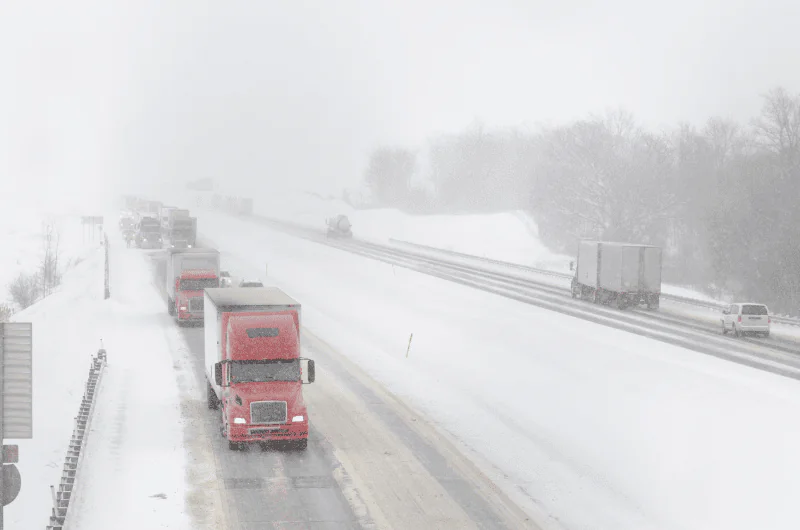How does weather affect the supply chain?
Weather is a natural occurrence that affects all aspects of our lives. And as you probably already know, with the supply chain, it’s no different. During the process of moving goods from the manufacturer to the customer, many things can go wrong without proper planning. What are the impacts of weather on the supply chain and how can you minimize the negative effects of weather on the supply chain?

Source: www.canva.com
The impact of weather on the supply chain
The supply chain is a complex system that involves several parties: from suppliers and manufacturers to distributors and retailers. Any perceptible disruption in this network can lead to delays, loss of revenue, and damage to a company’s reputation and relationships with customers. Unfortunately, weather can significantly disrupt the supply chain, leading to adverse effects.
Extreme natural conditions greatly impact the supply chain—for example, hurricanes, floods, and snowstorms. And with climate change, the weather will probably become more extreme every year. You can try to slow down the process by implementing green logistics solutions and try to prepare for extreme conditions.

Source: www.canva.com
Look at a few examples of how extreme natural conditions affected logistics and supply chains in the past:
- Hurricane Harvey (2017) in the United States caused flooding and infrastructure damage in Texas. Disrupting transportation networks and leading to delays in the movement of goods. Ports were closed, roads were impassable, and rail services were disrupted.
- Severe snowstorms and freezing temperatures (2010) in countries like the United Kingdom, Germany, and France caused closures of airports and cancellations of flights. This had a negative impact on the movement of perishable goods and caused delays and disruptions in supply chains.
- Typhoon Haiyan (2013) in the Philippines caused extensive damage to infrastructure, including ports and airports. This led to delays in the delivery of not only goods but also of relief supplies.
Cyclone Idai (2019) in Mozambique caused widespread flooding, destroying roads, making the transportation of goods extremely challenging. The disruption in the supply chain impacted industries such as agriculture, manufacturing, and construction. Those conditions can cause enormous transportation delays, making it difficult to transport cargo. Severe weather conditions can also lead to power outages, making it impossible to operate factories and warehouses, which can result in delays in production and shipment of goods. Heavy rains can also cause landslides, which can block roads and create enormous traffic jams full of loaded trucks.
How can weather impact the supply chain?
Because the weather is an unpredictable indicator, it is essential for companies to be prepared for all possible disruptions. How can weather affect the most crucial parts of the supply chain, production, and transportation?
Production and manufacturing errors
Weather can heavily impact the production and manufacturing of goods. According to recent research, inclement weather caused up to 30 % cancellation of an expected increase in European crop growth. Extreme weather conditions such as heatwaves, droughts, and floods can damage crops and affect the availability and quality of raw materials, which can disrupt the supply chain. For example, a drought in one region can lead to a shortage of a particular ingredient used in a product, causing delays or price increases. One example of extreme weather impacting production is the California drought in the United States from 2012 to 2016. The drought resulted in reduced water availability for irrigation. California is a major producer of a significant portion of the country’s nuts. Almonds need a lot of water to grow. Due to this, the almond industry faced challenges. As a result, almond production was affected, leading to higher almond prices and supply shortages in the market.
To mitigate production and manufacturing disruptions, companies can diversify their suppliers and have contingency plans in place for potential shortages. To diversify suppliers, companies need to research alternative suppliers and build relationships and negotiate contracts with them. They can also use weather monitoring tools to anticipate weather-related risks and adjust their production schedules accordingly.
Transportation disruptions
Weather can cause significant disruptions to transportation, which is a critical component of the stability of the supply chain. Storms, floods, and heavy snow can make roads and highways impassable, leading to delayed or canceled shipments. Additionally, hurricanes and strong winds can damage or block transportation infrastructure such as ports, airports, and railways, leading to prolonged closures and reduced capacity.
To get transportation disruptions under control as much as possible, you can plan ahead by diversifying their transportation options, such as choosing different routes or having backup transportation modes. You can also use weather tracking and forecasting tools to anticipate weather events and adjust your delivery schedules accordingly. One of the great tools to monitor weather can be climate data analysis tools that provide historical weather data and climate trends for specific locations. By analyzing long-term weather patterns, companies can identify trends and potential risks associated with specific weather events.
Another security measure is planning precise loadings. Logistic supply specialists can use loading software such as Easycargo to plan the most efficient loadings and use the lowest possible number of trucks. With fewer trucks on the road, you reduce your carbon footprint as well as money and risk of unexpected delays during extreme weather conditions.
Plan and be prepared for every storm
Weather is a crucial factor in supply chain management and companies must be prepared to alleviate potential disruptions. By understanding the various ways weather can impact the supply chain, such as transportation disruptions or production and manufacturing, your business can take proactive measures to minimize risks.




